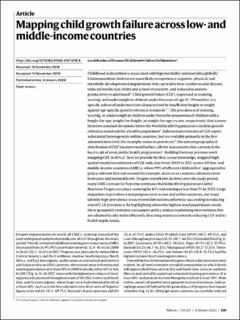| dc.description.abstract | Childhood malnutrition is associated with high morbidity and mortality globally. Undernourished children are more likely to experience cognitive, physical, and metabolic developmental impairments that can lead to later cardiovascular disease, reduced intellectual ability and school attainment, and reduced economic productivity in adulthood. Child growth failure (CGF), expressed as stunting, wasting, and underweight in children under five years of age (0–59 months), is a specific subset of undernutrition characterized by insufficient height or weight against age-specific growth reference standards, The prevalence of stunting, wasting, or underweight in children under five is the proportion of children with a height-for-age, weight-for-height, or weight-for-age z-score, respectively, that is more than two standard deviations below the World Health Organization’s median growth reference standards for a healthy population. Subnational estimates of CGF report substantial heterogeneity within countries, but are available primarily at the first administrative level (for example, states or provinces; the uneven geographical distribution of CGF has motivated further calls for assessments that can match the local scale of many public health programmes. Building from our previous work mapping CGF in Africa, here we provide the first, to our knowledge, mapped high-spatial-resolution estimates of CGF indicators from 2000 to 2017 across 105 low- and middle-income countries (LMICs), where 99% of affected children live, aggregated to policy-relevant first and second (for example, districts or counties) administrative-level units and national levels. Despite remarkable declines over the study period, many LMICs remain far from the ambitious World Health Organization Global Nutrition Targets to reduce stunting by 40% and wasting to less than 5% by 2025. Large disparities in prevalence and progress exist across and within countries; our maps identify high-prevalence areas even within nations otherwise succeeding in reducing overall CGF prevalence. By highlighting where the highest-need populations reside, these geospatial estimates can support policy-makers in planning interventions that are adapted locally and in efficiently directing resources towards reducing CGF and its health implications. | en_US |

